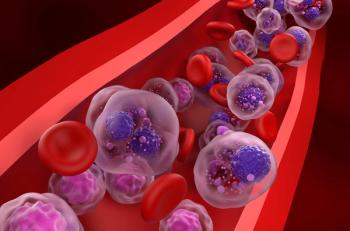
Single Cycle of Chemotherapy Reduced Testicular Cancer Recurrence
Recurrence rate was 1.3% in patients treated with 1 cycle of chemotherapy.
A single treatment with adjuvant bleomycin, etoposide, and cisplatin (BEP) was found to result in a low recurrence rate in men with newly diagnosed, high-risk, stage 1 nonseminomatous or combined germ cell tumors of the testis (NSGCTT), according to a phase 3 clinical trial presented at the American Society of Clinical Oncology 2017 Genitourinary Cancers Symposium.
In the UK, standard post-orchiectomy treatment includes surveillance and treatment with 3 cycles of bleomycin, etoposide, and cisplatin (BE500P) or 2 cycles of the adjuvant treatment (BE360P). Although the adjuvant treatment is observed to have a 98% 2-year recurrence rate, it increases chemotherapy administration by 33%, while lower chemotherapy exposure necessitates surveillance.
“Evidence has begun to accumulate that maybe one cycle is enough,” said researcher Robert Huddart, PhD, who presented the study.
One cycle of chemotherapy would likely reduce symptoms experienced by the patients, reduce costs, and limit healthcare usage, according to the study.
Since there was already extensive data for the BE360P treatment option and on surveillance, the clinical trial was designed as a single-arm study. Included in the trial were 246 patients aged 16 to 31 diagnosed with NSGCTT or mixed germ cell tumor of the testis with vascular invasion of the primary tumor into the testicular veins or lymphatics.
In addition to chemotherapy, patients received prophylactic granulocyte colony-stimulating factor, and antibiotic treatment. The investigators noted they worked to reduce the risk of neutropenic sepsis.
At 2 years, there were only 3 recurrent cancers, with a 2-year event rate of 1.3%, according to the study. The overall survival was observed to be 99% at this time, with 1 patient dying from testicular cancer and 1 from a second primary tumor.
The toxicity of the treatment was as expected, with 32.2% experiencing grade 3 or 4 neutropenia, according to the presentation. Other toxicities included leukopenia, febrile neutropenia, and thrombocytopenia.
Approximately 90.9% of patients experienced delayed toxicity, with 59.4% experiencing grade 1 and 28% experiencing grade 2 toxicities. Delayed toxic effects included dysponoea,
These findings suggest that younger patients may benefit the most from treatment with 1 cycle of adjuvant treatment. Not only will this reduce side effects, but it will also decrease costs related to treatment.
These findings may lead to a reduction in chemotherapy for certain patients, but others may still require a more aggressive 2 or 3 cycle treatment.
“Adoption of this protocol would reduce the overexposure to chemotherapy in a young patient population,” Dr Huddart said.
Newsletter
Stay informed on drug updates, treatment guidelines, and pharmacy practice trends—subscribe to Pharmacy Times for weekly clinical insights.






































































































































































































